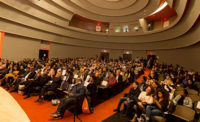Boston's young and mid-career practices find common ground in their training and research-based design.
The New Establishment
Members of the newly emerged generation of Boston architects would cavil with the notion that they are in any way a new establishment—a common theme in all of these practices is not one of style but the imperative for constant critical enquiry. If there is any merit in the attempt to identify a DNA of Boston architecture, it is to find it in the uniform rejection of such complacent categorization.

Anmahian Winton Architects
Alex Anmahian, AIA, and Nick Winton, AIA, graduated from the Harvard GSD in 1990 and a year later formed their partnership, now a 14-person firm. Most of their current work is with local universities and institutions or private residences. They’ve also worked in Lebanon, where Anmahian has family ties. Unashamedly Modernist in their philosophy, they are now in a position where they can choose to work with those who are ready to engage with them in architectural discussion. Anmahian cites the Community Rowing Boathouse as the outcome of architect and client engaging in vigorous debate on building a 21st-century facility on a “19th-century river.”
Brian Healy Architects
A graduate of Penn State and Yale, Brian Healy, AIA, set up his practice in 1988. He says the attraction of Boston was “the intense culture of astute, well-educated people,” as well as the legacy of Le Corbusier, Sert, and others within the historic fabric of the city. Healy relishes the challenge of developing “a contemporary language in a traditional setting” and finds this skill translatable to the work his office has up and down the East Coast. Even with a firm of eight, Healy finds the time to teach, to serve as president of the BSA, and to run the society’s “Conversations” series of evening seminars with leading designers.
designLAB architects
Robert J. Miklos, FAIA, and Scott Slarsky, both mid-careerists with considerable experience in Boston firms, founded designLAB in 2004. They have managed to attract major cultural and educational clients all over the country. The name designLAB reflects the principals’ commitment to “design as a vehicle for helping institutions do their job,” Miklos says. Generating form is not their primary goal. Rather, they see their research and critical analysis of a client’s program as the starting point for design process and architectural resolution. Miklos also takes pride in the nonhierarchical, nimble, low-overhead quality of the 10-person firm—qualities he seeks to maintain even as it grows.
Kennedy & Violich Architecture
Sheila Kennedy, AIA, from the Sorbonne, and Frano Violich, AIA, from Berkeley, met at the Harvard GSD. After graduating, they established, in 1988, a “proactive, research-based practice,” suspicious of “the complacency of accepted ideas” and “daring to be different.” The firm has earned a national reputation as an innovative practice engaged in research and product design fully integrated into architecture, at the same time maintaining its intensity by staying small, with just 14 people. Their work on integrating distributed energy generation systems into their architecture is manifested in their “Portable Light” project and on a larger scale with the as-yet-unbuilt East 34th Street Ferry Terminal in Manhattan.
Office dA
Both products of the Harvard GSD and the Machado and Silvetti practice, Nader Tehrani and Monica Ponce de Leon founded Office dA in 1991, impatient to build [record, April 2006, page 114; June 2007, page 200]. In their focus on detailing and materials through digital manufacturing, their ambition is to “marry local craft and tradition to global and contemporary techniques.” Teaching and practice is essential to their work. Tehrani talks of being a “profound pragmatist” while maintaining a critical edge through “a constant dissatisfaction with our work.” Their location in Boston was for long merely circumstantial, as they built all over the world and the United States, but their work on the Macallen Building Condominiums has brought with it a new commitment to the city.


